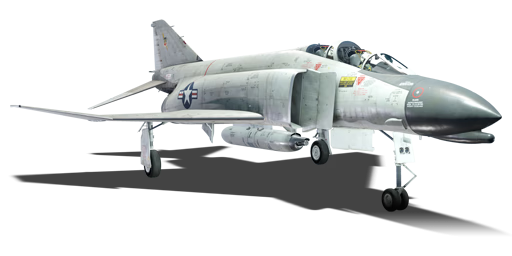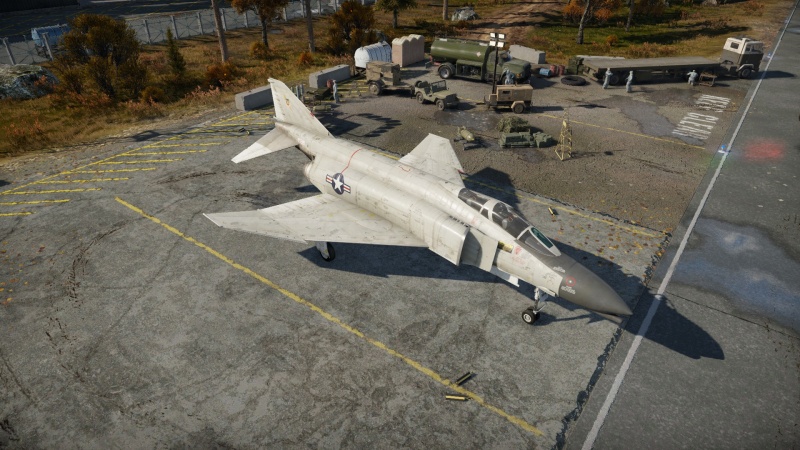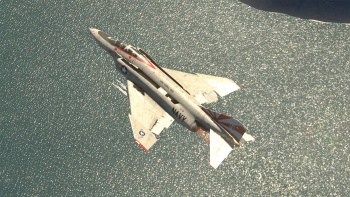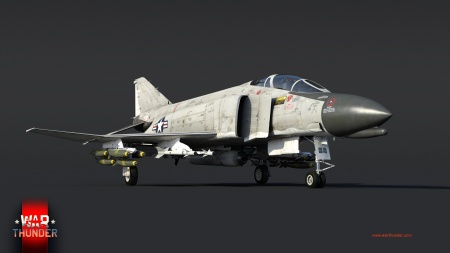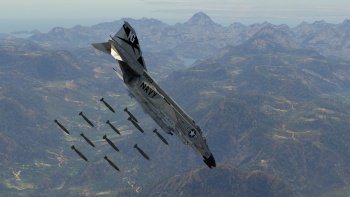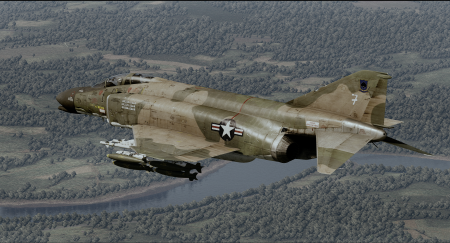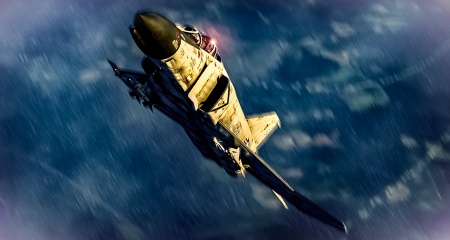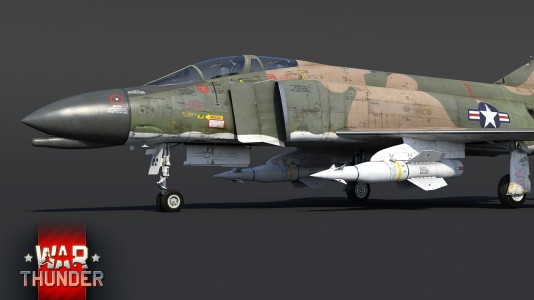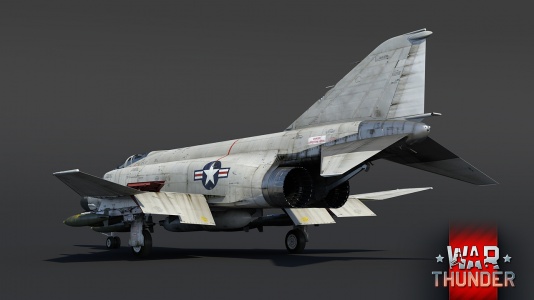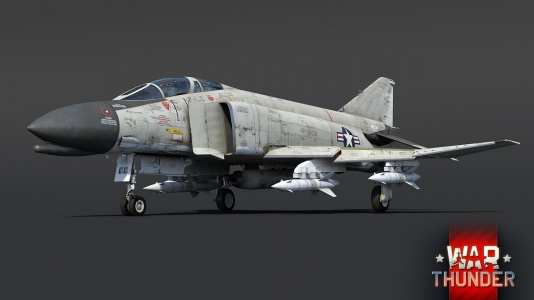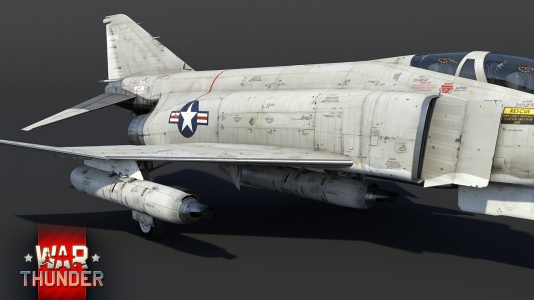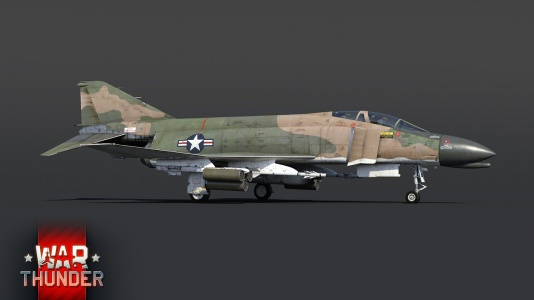Difference between revisions of "F-4C Phantom II"
(updates to bad matchups and cons) (Tag: Visual edit) |
(grammar fixes and update to include the mirages) (Tag: Visual edit) |
||
| Line 225: | Line 225: | ||
;Most dangerous enemies | ;Most dangerous enemies | ||
| − | MiG fighters and [[VTOL]] aircraft tend to be the most dangerous enemies, especially the MiG-21 and Harrier variants, which are quite agile and can typically outmanoeuvre the F-4. The max speed of the MiG-21 | + | MiG fighters, Mirages, and [[VTOL]] aircraft tend to be the most dangerous enemies, especially the MiG-21 and Harrier variants, which are quite agile and can typically outmanoeuvre the F-4. The max speed of the MiG-21 and the Mirages are comparable with the F-4, whereas aircraft such as the earlier MiG 17 and 19 will get left in the dust as they are almost half as fast. The early MiG-21 variants like the [[MiG-21F-13]] and [[J-7II]] can carry the R-3S/PL-2, missiles similar to the AIM-9B but inferior to the AIM-9E. They can also be equipped with rockets, and the internal 30 mm cannon(s) can rip through the {{PAGENAME}} with careful aiming. The best bet against a MiG-21 is to attempt to first cripple the aircraft either during a head-on approach or through a missile, rocket or gun attack, once it is operating at less than 100% it will be easier to manoeuvre around it and set up for the killing blow. When facing a Harrier, Hunter, Mirage, or other Phantom variant the same strategy applies as they can be difficult to outmanoeuvre when in pristine shape. Although with the Phantoms and Mirages, it is best to avoid a head on approach due to the potential danger of a wall of fire from triple SUU-23/A gunpods (from the Phantoms) or taking a radar guided missile to the face (from both the Phantoms and the Mirages). Be wary of aircraft like the [[Mirage IIIC]], [[Mirage IIIE]], [[MiG-21SMT]],[[MiG-21MF (Germany) | MiG-21MF]], [[Yak-38 (Family)|Yak-38's]], [[Hunter F.6]], and [[Harrier GR.1]] as they can carry up to four (two in the case of the Yak-38's and Mirages) high-performance missiles such as the [[R-60]] for the MiG-21's and Yak-38's, the [[SRAAM]]'s for the Hunter and Harrier, and the [[Matra R550 Magic 1]] missile for the Mirages respectively. These are air-to-air missiles with high agility and high-aspect capability that are extremely difficult to dodge without countermeasures (something the F-4C lacks). Furthermore, foreign variants of the Phantom can match you in performance and often come equipped with later (higher-performing) variants of the Sidewinder and Sparrow missiles. |
=== Pros and cons === | === Pros and cons === | ||
Revision as of 16:05, 13 May 2021
| This page is about the jet fighter F-4C Phantom II. For other versions, see F-4 Phantom II (Family). |
Contents
Description
The F-4C Phantom II is a rank VII American jet fighter with a battle rating of 10.7 (AB/SB) and 10.3 (RB). It was introduced in Update 1.91 "Night Vision".
Development of fighter aircraft attempts to balance size, speed, armament and manoeuvrability to come up with the perfect fighter. Due to the difficulties and challenges of bundling all of these in one aircraft, many different varieties have been developed through the years which highlighted one or more aspects but rarely all in one. And sometimes the mould had to be broken and the motto "bigger IS better" came into play. Due to these such heavyweight fighters like the P-61, Me 410, Beaufighter, J5N1 and SM.91 were developed to fly faster, remain manoeuvrable and carry heavier weapons and ordnance, sometimes much heavier than their lighter counterparts. The F-4C Phantom II is no exception, originally developed as a souped-up F-3H Demon, this fighter was modified into a larger, heavier, faster fighter-interceptor/bomber that the U.S. Navy didn't realize it needed and when it did, it went all in.[1]
The imposing F-4C Phantom II can seem a bit intimidating at first due to its size, but the pilot will quickly find that with the dual J79-GE-15 engines that this fighter is no slouch. Going from takeoff, acceleration in a climb and to level flight the F-4C Phantom II will move and is quite agile for an aircraft of its size. More than capable as a dogfighter, it, however, has many options up its sleeve to deal with enemy aircraft it may encounter. Pilots new to the F-4C Phantom II will initially be set up with an M61 20 mm cannon. Due to this aircraft not being configured with an internal cannon, one was required to be mounted on a centre-line pylon. Options become available to mount two additional 20 mm cannon gun pods, one under each wing which all together will spew out a slew of 20 mm rounds acting like a shotgun effect even at >500 m. AIM-9B and AIM-9E Sidewinder missiles round out the Phantom's anti-air capabilities and are solid missiles to use against enemy aircraft which will cause the enemy pilot to take evasive manoeuvres to avoid the missile. In the event that happens, be ready with the cannons for backup as the enemy pilot should be an easy target after bleeding all of their speed and energy avoiding the missile.
Another arena where the F-4C Phantom II shines is in the ground-pounding or ground attack function of the aircraft. With eleven hardpoints, this fighter/bomber can be configured in many different ways to carry a combination of guns, bombs and rockets. When it comes to bombs, the F-4C Phantom II has the option to use either 250 lb, 500 lb, 750 lb or 1,000 lb bombs and can hold upwards of 9,000 lbs total! The Phantom also has three different rocket types to choose from, depending on the targets you are going after. These range from anti-tank AGM-12B and AGM-12C Bullpup guided rockets, Zuni Mk32 anti-tank rockets and the small but powerful FFAR Mighty Mouse in a volume of 228, which can be devastating when used en masse.
The amazing F-4 Phantom II was state-of-the-art in its day and even 60 years later, several countries are still utilising this iconic fighter/bomber as a force multiplier with their air forces today. This fighter coupled with a pilots skill and determination can help alter the outcome in the jet-battle matches.
General info
Flight performance
The F-4C Phantom II is an incredibly stable aircraft, however from the way its wingtips and tailplanes look, one might think otherwise. Due to extensive wind tunnel testing, McDonnell engineers determined that by canting the tailplanes downward at a 23° anhedral (inclination) the stability and stall recovery characteristics of the aircraft dramatically improved and in the same fashion they didn't interfere with the engine's jet exhaust. The wings, on the other hand, were developed to be extremely strong to support large suspended armaments; however, they needed to be given a 5° upward inclination, though, to prevent having to redesign the entire wing, the engineers elected to just raise the wingtips at 12° dihedral which averaged the wing at the necessary 5°. The iconic shape of the F-4C Phantom II was set.[1]
With the airframe, wings and tailplanes set in place, the fighter became a stable and solid aircraft. Stability is especially critical with a jet which closes in on the Mach 2 mark. Early speed trials identified flaws in the aircraft which at times proved fatal, but corrections and modifications for later aircraft increased their stability and airworthiness which saved many pilots with damaged aircraft. The F-4C Phantom II is powered by two General Electric J79-GE-15 engines which are necessary to keep the fighter/bomber in the sky, especially with heavy ordnance loads, however, these engines don't bog down too much under heavy loads as it will still accelerate in a climb, during level flight and during a dive. A testament to the jet and its engines, during one altitude test, the F-4 flew Mach 2 all the way to 90,000 feet where the engines were shut off and the plane coasted up to 98,000 ft, slowing to almost 45 mph and upon dropping back to Earth, fired up its engines at around 70,000 ft and successfully landed.
The Phantom II has the speed and acceleration and also has sufficient manoeuvrability. As a low altitude bomber, the F-4C Phantom II needed to be manoeuvrable or else it would have been an easier target for either the MiG fighters or the anti-aircraft ground fire. Even with heavy ordnance loads, the Phantom II could still shimmy into position, release its ordnance and then rocket away to a higher altitude. Pilots found out early on that some MiG fighters like the -17 were extremely manoeuvrable and had to be prepared to nullify the target to prevent the MiG from getting behind them. For the F-4C Phantom II pilot, it is important when bombing targets to keep a look around and watch for enemy fighters attempting to swoop in, attack the ground target and rocket up to safety. When flying at altitude, be careful not to get into a turning fight as the Phantom is a very heavy aircraft and does not turn very well, instead fly fast and work with Boom & Zoom techniques and always watch your six as a MiG may try to sneak up from behind.
| Characteristics | Max Speed (km/h at 12,192 m) |
Max altitude (metres) |
Turn time (seconds) |
Rate of climb (metres/second) |
Take-off run (metres) | |||
|---|---|---|---|---|---|---|---|---|
| AB | RB | AB | RB | AB | RB | |||
| Stock | 2,230 | 2,204 | 16000 | 26.4 | 27.9 | 144.1 | 135.0 | 850 |
| Upgraded | 2,362 | 2,288 | 25.6 | 26.0 | 202.1 | 172.0 | ||
Details
| Features | |||||
|---|---|---|---|---|---|
| Combat flaps | Take-off flaps | Landing flaps | Air brakes | Arrestor gear | Drogue chute |
| X | ✓ | ✓ | ✓ | ✓ | ✓ |
| Limits | ||||||
|---|---|---|---|---|---|---|
| Wings (km/h) | Gear (km/h) | Flaps (km/h) | Max Static G | |||
| Combat | Take-off | Landing | + | - | ||
| 1458 | 463 | N/A | 580 | 463 | ~11 | ~4 |
| Optimal velocities (km/h) | |||
|---|---|---|---|
| Ailerons | Rudder | Elevators | Radiator |
| < 810 | < 750 | < 700 | N/A |
Engine performance
| Engine | Aircraft mass | |||||
|---|---|---|---|---|---|---|
| Engine name | Number | Empty mass | Wing loading (full fuel) | |||
| General Electric J79-GE-15 | 2 | 13,900 kg | 402 kg/m2 | |||
| Engine characteristics | Mass with fuel (no weapons load) | Max Takeoff Weight | ||||
| Weight (each) | Type | 9m fuel | 20m fuel | 32m fuel | ||
| 1,720 kg | Afterburning axial-flow turbojet | 15,610 kg | 18,124 kg | 19,799 kg | 24,000 kg | |
| Maximum engine thrust @ 0 m (RB / SB) | Thrust to weight ratio @ 0 m (WEP) | |||||
| Condition | 100% | WEP | 9m fuel | 20m fuel | 32m fuel | MTOW |
| Stationary | 4,910 kgf | 7,561 kgf | 0.97 | 0.83 | 0.76 | 0.63 |
| Optimal | 4,910 kgf (0 km/h) |
8,856 kgf (1,200 km/h) |
1.13 | 0.98 | 0.89 | 0.74 |
Survivability and armour
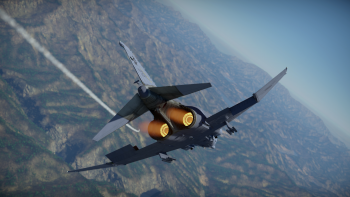
Due to the sheer weight of the F-4C Phantom II it is surprising to note that there is no armour plating nor any bulletproof canopies. Littered with eight fuel tanks, one in each wing and the other six in the fuselage right above the engines, there isn't much protection for the self-sealing tanks. The Phantom pilot will need to be cognizant of where enemy aircraft are behind them to ensure they prevent their aircraft from taking damage as speed and manoeuvrability are the keys to survival and if lost, there is not much hope for the fighter.
For those aircraft attacking the F-4C Phantom II, when using machine guns and cannons you can try to blow off a wing or snipe the pilot, however, your best bet will be to aim for centre fuselage where you have the greatest chance of hitting several fuel tanks or even the engines. Firing missiles will cause the pilot to take evasive manoeuvres which may cause the aircraft to pitch up or down which will expose the greatest surface area allowing your guns or cannons to finish the fight as for without any armour, only the thin metal skin separates the incoming bullets from critical F-4C Phantom II components.
Modifications and economy
Armaments
| Ballistic Computer | |||
|---|---|---|---|
| CCIP (Guns) | CCIP (Rockets) | CCIP (Bombs) | CCRP (Bombs) |
| |
|
|
|
Suspended armament
The F-4C Phantom II can be outfitted with the following ordnance:
- 1 x 20 mm M61 Vulcan rotary cannon in a SUU-16/SUU-23 gun pod (1,200 rpg)
- 2 x additional SUU-16/SUU-23 gun pods for a total of 3 x M61 Vulcan 20 mm cannons (1,200 rpg = 3,600 total)
- 1 x 20 mm M61 cannon + 18 x 250 lb LDGP Mk 81 bombs (4,500 lb total)
- 1 x 20 mm M61 cannon + 18 x 500 lb LDGP Mk 82 bombs (9,000 lb total)
- 1 x 20 mm M61 cannon + 12 x 750 lb M117 cone 45 bombs (9,000 lb total)
- 1 x 20 mm M61 cannon + 8 x 1,000 lb LDGP Mk 83 bombs (8,000 lb total)
- 1 x 20 mm M61 cannon + 4 x AGM-12B Bullpup missiles
- 1 x 20 mm M61 cannon + 2 x AGM-12C Bullpup missiles
- 1 x 20 mm M61 cannon + 228 x FFAR Mighty Mouse rockets
- 1 x 20 mm M61 cannon + 48 x Zuni Mk32 Mod 0 ATAP rockets
- 1 x 20 mm M61 cannon + 4 x AIM-9B Sidewinder missiles
- 1 x 20 mm M61 cannon + 4 x AIM-9B Sidewinder missiles + 12 x 250 lb LDGP Mk 81 bombs (3,000 lb total)
- 1 x 20 mm M61 cannon + 4 x AIM-9B Sidewinder missiles + 12 x 500 lb LDGP Mk 82 bombs (6,000 lb total)
- 1 x 20 mm M61 cannon + 4 x AIM-9B Sidewinder missiles + 6 x 750 lb M117 cone 45 bombs (4,500 lb total)
- 1 x 20 mm M61 cannon + 4 x AIM-9B Sidewinder missiles + 4 x 1,000 lb LDGP Mk 83 bombs (4,000 lb total)
- 1 x 20 mm M61 cannon + 4 x AIM-9B Sidewinder missiles + 114 x FFAR Mighty Mouse rockets
- 1 x 20 mm M61 cannon + 4 x AIM-9B Sidewinder missiles + 24 x Zuni Mk32 Mod 0 ATAP rockets
- 1 x 20 mm M61 cannon + 2 x AGM-12B Bullpup missiles + 4 x AIM-9B Sidewinder missiles
- 4 x AIM-9B Sidewinder missiles
- 1 x 20 mm M61 cannon + 4 x AIM-9E Sidewinder missiles
- 4 x AIM-9E Sidewinder missiles
- 1 x 20 mm M61 cannon + 4 x AIM-7D Sparrow missiles
- 1 x 20 mm M61 cannon + 4 x AIM-7D Sparrow missiles + 18 x 250 lb LDGP Mk 81 bombs (4,500 lb total)
- 1 x 20 mm M61 cannon + 4 x AIM-7D Sparrow missiles + 18 x 500 lb LDGP Mk 82 bombs (9,000 lb total)
- 1 x 20 mm M61 cannon + 4 x AIM-7D Sparrow missiles + 12 x 750 lb M117 cone 45 bombs (9,000 lb total)
- 1 x 20 mm M61 cannon + 4 x AIM-7D Sparrow missiles + 8 x 1,000 lb LDGP Mk 83 bombs (8,000 lb total)
- 1 x 20 mm M61 cannon + 4 x AIM-7D Sparrow missiles + 4 x AIM-9B Sidewinder missiles + 12 x 250 lb LDGP Mk 81 bombs (3,000 lb total)
- 1 x 20 mm M61 cannon + 4 x AIM-7D Sparrow missiles + 4 x AIM-9B Sidewinder missiles + 12 x 500 lb LDGP Mk 82 bombs (6,000 lb total)
- 1 x 20 mm M61 cannon + 4 x AIM-7D Sparrow missiles + 4 x AIM-9B Sidewinder missiles + 6 x 750 lb M117 cone 45 bombs (4,500 lb total)
- 1 x 20 mm M61 cannon + 4 x AIM-7D Sparrow missiles + 4 x AIM-9B Sidewinder missiles + 4 x 1,000 lb LDGP Mk 83 bombs (4,000 lb total)
- 4 x AIM-7D Sparrow missiles + 4 x AIM-9B Sidewinder missiles
- 1 x 20 mm M61 cannon + 4 x AIM-7D Sparrow missiles + 4 x AIM-9E Sidewinder missiles
- 4 x AIM-7D Sparrow missiles + 4 x AIM-9E Sidewinder missiles
It is rare for a fighter not to have any native offensive weapons, typically this is a situation you would find on a bomber. The F-4C Phantom II is unique in that what it lacks in offensive weapons, it more than makes up for in suspended weapons. With a total of 11 hardpoint pylons, an array of guns, bombs, rockets and missiles can be added, fully customizing the mission to suit the needs of the pilot. The pilot has the choice of configuring for air-to-air, air-to-ground or a mixture of both (bombs and Bullpup rockets are ground attack only, missiles are air-to-air attack only while the cannons, Zuni and FFAR rockets can be used for both).
In regards to air-to-air combat, the F-4C Phantom II is hard-pressed to find a competitor on equal footing, but that can be found with an exceptional pilot flying a less than equal aircraft. This fighter is fast and with its speed, it can relatively sneak up on enemy fighters by closing the gap on the field with its twin J79-GE-15 engines. Once in place and the enemy is in range, two options are available, guns or missiles? The M-61 Vulcan cannon can spew 20 mm rounds at the rate of just over 6,000 rounds per minute (roughly 100 per second), now multiply that by three (if the Phantom is configured for three gun pods) and you can see devastating firepower which will be difficult for any enemy aircraft to avoid. Even just quick bursts at a manoeuvring fighter can be enough to inflict critical damage or even blowing off a wing. Ground attack with the guns can be effective on lighter armoured vehicles with just a few quick bursts.
The AIM-9B and AIM-9E Sidewinders are the missile options available for the F-4C Phantom II. During the Vietnam War, when US Air Force models of the Phantom like the F-4C and F-4D began operations, they did so without the capability of mounting AIM-9 Sidewinder missiles as the Navy models did, instead using the AIM-4 Falcon. Falcons had gained a reputation of not being reliable (not firing, not tracking, not exploding) so several squadrons had their fighters field-modified with the ability to mount their trusted Sidewinder missiles. Here on the F-4C Phantom II, four Sidewinders are available and are effective at hounding down an aircraft when a lock is acquired. However, they are not guaranteed to hit, as a competent pilot can avoid them with hard maneuvering, flying towards the sun, etc. However these actions will often hamper the target's speed and situational awareness, making them an easier target to clean up with the cannons.
Zuni and FFAR rockets can be utilised effectively against bombers or even against other fighters, especially during a head-on. Though unguided and not very accurate, usually a salvo of these rockets is enough to cause an enemy to panic into an unexpected manoeuvre. Usage of these rockets on ground targets works very well too. Again, with them being unguided, shooting them en masse ensure a greater possibility of one or more to hit the target. The AGM-12B Bullpup rockets are excellent rockets to use against ground targets, however, the one drawback is that it needs to be guided in by the pilot, so if there are any distractions to the pilot, the rocket will likely go off course and miss the target.
9,000 lbs. Yes, you read that number correctly, the F-4C Phantom II can carry up to 9,000 lbs of bombs, which is half of what a B-29 bomber could carry, however, the Phantom is quite a bit more accurate dropping from much lower altitudes. Using combinations of 250, 500, 750 and 1,000 lb bombs allows the pilot to pick targets accordingly. To ensure the F-4C Phantom II is not left defenceless after the bombs are away, each configuration has at least one 20 mm cannon pod and/or AIM-9B missiles to go with it.
Usage in battles
The F-4C Phantom II relies on brute force to get its job done. With this version of the Phantom II, there is no protective armour, there are no defensive weapons and there are no countermeasures to ward off the enemy and the weapons they bring to the table. As a brute, the Phantom II muscles its way into a fight, it brings the big guns whether it is cannons, rockets, bombs, missiles or any combination of them and when it does bring them, it brings lots of them. When attacking a Phantom, don't assume it is just a fighter, interceptor or a bomber as it can switch roles on the fly depending on its suspended armament loadout and what needs to be done.
- Air-to-air
The F-4C Phantom II was originally developed to be an all-weather fleet defensive interceptor for the U.S. Navy, however that role was already taken by the Vought F-8 Crusader, so going back to the drawing board, McDonnell engineers reconfigured the Phantom II so that it can be more versatile and be configured with weapons to suit the mission needed or the branch of military it would be flying for.[1] Though large and intimidating, the Phantom II is a fast-moving beast of an aircraft which can hold its own in air-to-air combat. Due to its size and weight, turn fighting is not the best way to handle the aircraft as with its speed, acceleration and climbing abilities, it can Boom & Zoom with the best of them.
Typically two weapons can be mounted which help this fighter excel in combat of this type and which are AIM-9B Sidewinder missiles and M-61 Vulcan cannons (in a configuration of one or three). The Vulcan cannons can spray the area in front of the Phantom II with an insane amount of 20 mm rounds, especially when three gun pods are mounted which almost has a shotgun scatter effect by the time it gets to where the enemy fighter is and should put enough holes in it with a few quick bursts to get a critical or even just destroy the enemy aircraft. Sometimes the cannons may not be the right option and for this, the AIM-9B comes into play. The Sidewinder missile is very effective and has a very low failure rate, though, in the hands of a good pilot, an enemy fighter does have a chance to evade the missile. The F-4C Phantom II carries four AIM-9Bs and can utilize them to "spook" an enemy aircraft which might have an energy advantage to attempt energy bleeding manoeuvres to avoid the missile only inadvertently actually setting them up for an easy fly-by kill with the Phantom II's cannons. Missiles are also helpful for finishing off enemies that are unable to dodge them due to battle damage or a lack of energy.
Rockets are another option for this aircraft, however for air-to-air combat, the Folding-Fin Aerial Rockets are the best bet of the three as they were designed to be fired off in large groups to take down large bombers, however, the Phantom II can make use of them not only with bombers but also against fighters attempting a head-on pass or even aircraft landing on airfield in domination matches, as a salvo of missiles will end short their attempt to capture the airfield.
- Ground pounding
The F-4C Phantom II was not called a Mud Mover for nothing as with its legendary suspended ordnance options it can quickly reshape the landscape with bombs and rockets.[1] One of the other configurations the McDonnell engineers designed the Phantom II for was to fit the role of a bomber. Knowing ahead of time this option would increase the fighters value as a force multiplier, the aircraft's wings were originally super strengthened to support eleven hardpoint pylons to allow for up to 9,000 lbs of bombs to be carried (to keep this in perspective, two F-4C Phantom IIs with four crew members could carry the same max weight of bombs of what one B-29 bomber with a total crew of 10 could but could do it a lot faster and at a lot lower altitude). The bomb options for the Phantom II range from 250, 500, 750 and 1,000 lb bombs which will allow this fighter/bomber to virtually attack any ground target on the map to include large bases. As a bonus, once all of the bombs have been dropped, the F-4 will not be a sitting duck while waiting for the reload timer (arcade) or when heading back to base (realistic and simulator) to reload as each loadout option includes one 20 mm gun pod to allow for a continued attack. Zuni and FFAR Might Mouse rockets can be used for great effect on vehicles and anti-aircraft sites, especially those which are clustered close together, however against heavy pillboxes and heavy tanks they might not do much. The final option is to outfit the AGM-12B or AGM-12C Bullpup rockets. These rockets are a mixed bag for the pilot as they excel at being used against tanks due to their 250 lb warhead; however, on the flip side, these rockets are MCLOS (manual command line of sight) which requires the Phantom II pilot to guide the rocket all the way to the target. Any cause for pilot deviation could potentially throw the Bullpup off course. During the guiding phase of Bullpup on the way to the target, a Phantom II is vulnerable as the pilot cannot be looking around for incoming enemy aircraft and must keep a visual on the target until the rocket hits its target.
- Bait attack
The F-4C Phantom II is a phenomenal aircraft to use in a group manoeuvre known as a baiting attack. This fighter can play both roles as either the bait or an attacking aircraft. For this to work, the Phantom II can be used as the bait aircraft, which flies in a way to attract the attention of an enemy fighter (or two), after closing in, the Phantom II should use its speed and acceleration to go into a climb, almost like setting up for a rope-a-dope manoeuvre. While the enemy aircraft are attempting to chase the F-4 in the climb the group buddies can swoop in and take out the distracted enemy aircraft. Due to the fast speed and acceleration of the F-4, it can also be used as the support aircraft in the manoeuvre as with its cannons and missiles; it can lunge in to take out the baited enemy fighters.
- Most dangerous enemies
MiG fighters, Mirages, and VTOL aircraft tend to be the most dangerous enemies, especially the MiG-21 and Harrier variants, which are quite agile and can typically outmanoeuvre the F-4. The max speed of the MiG-21 and the Mirages are comparable with the F-4, whereas aircraft such as the earlier MiG 17 and 19 will get left in the dust as they are almost half as fast. The early MiG-21 variants like the MiG-21F-13 and J-7II can carry the R-3S/PL-2, missiles similar to the AIM-9B but inferior to the AIM-9E. They can also be equipped with rockets, and the internal 30 mm cannon(s) can rip through the F-4C Phantom II with careful aiming. The best bet against a MiG-21 is to attempt to first cripple the aircraft either during a head-on approach or through a missile, rocket or gun attack, once it is operating at less than 100% it will be easier to manoeuvre around it and set up for the killing blow. When facing a Harrier, Hunter, Mirage, or other Phantom variant the same strategy applies as they can be difficult to outmanoeuvre when in pristine shape. Although with the Phantoms and Mirages, it is best to avoid a head on approach due to the potential danger of a wall of fire from triple SUU-23/A gunpods (from the Phantoms) or taking a radar guided missile to the face (from both the Phantoms and the Mirages). Be wary of aircraft like the Mirage IIIC, Mirage IIIE, MiG-21SMT, MiG-21MF, Yak-38's, Hunter F.6, and Harrier GR.1 as they can carry up to four (two in the case of the Yak-38's and Mirages) high-performance missiles such as the R-60 for the MiG-21's and Yak-38's, the SRAAM's for the Hunter and Harrier, and the Matra R550 Magic 1 missile for the Mirages respectively. These are air-to-air missiles with high agility and high-aspect capability that are extremely difficult to dodge without countermeasures (something the F-4C lacks). Furthermore, foreign variants of the Phantom can match you in performance and often come equipped with later (higher-performing) variants of the Sidewinder and Sparrow missiles.
Pros and cons
Pros:
- Centre-line gun pod is available in all load-out configurations no matter the desired secondary ordnance, but can also be removed in certain load-outs for a performance boost
- Wide variety of payload options to include 20 mm cannons, rockets, missiles and bombs
- One of the fastest aircraft in the game pushing Mach 2
- Has access to the AIM-9B/E Sidewinders and the AIM-7D Sparrow air-to-air missiles
- Fantastic rate of climb
- Excellent acceleration
- Good roll rate for a larger aircraft
- M61 Vulcan is devastating to enemy aircraft (especially when three gun pods are outfitted)
Cons:
- The gun pods are pointed slightly downwards (pilot must adjust aim to compensate)
- Large target profile compared to other fighters it will fly against
- Poor turning ability unless using minimum fuel
- When maxed out at 24 t (21,800 kg/48,000 lb) manoeuvrability suffers
- Using wing-mounted hardpoints will break wings at low altitudes while flying Mach +1.10
- No countermeasures
- AIM-7D Sparrow missiles are notoriously poor performing
| Fun Fact: The F-4C Phantom II's air-intake splitters each have 12,500 small holes drilled into them to reduce incoming turbulence and allow the maximum amount of ram air available into the air-intakes for the engines. |
History
McDonnell Aircraft Corporation began operations in 1939, though it didn't produce any fighter aircraft for the second great war, it did make a name for itself manufacturing aircraft parts for other aircraft. Though the company worked on a prototype twin-engine, single-seat interceptor aircraft, the XP-67 Bat (also known as Moonbat), the destruction of the prototype due to an engine fire caused the project to be cancelled. However, starting in 1943, McDonnell began developing jet aircraft and successfully produced the FH-1 Phantom during the post-war era.[1] The success of the Phantom prompted other McDonnell aircraft to have similar features such as the dual engines placed forward under the fuselage and exiting just behind the wings, unlike many single-engine jet fighters which ran the rear length of the aircraft and exited out the rear. Follow on aircraft which shared the engine style of the Phantom was the F2H Banshee, F3H Demon and the F-101 Voodoo.[1]
Though McDonnell had initial success with the Phantom and Banshee, they started having problems with the Demon, though it was not because of the aircraft itself, however, it was because of the engines it was outfitted with. The aircraft was sound in its construction and aerodynamics. Later after the Westinghouse XJ40 turbojet was replaced with the Allison J71, the Demon saw greater success.[1] The F-101 Voodoo was an excellent performing aircraft which fulfilled its multi-role capability as an interceptor, fighter/bomber and reconnaissance aircraft, however, when going up against Vought Aircraft Company for a contract with the Navy, McDonnell lost out with the F-8 Crusader being the winner[2].
McDonnell's response to this failure was to task their design team to build a fighter aircraft that the Navy could not refuse, but they did not yet know they needed. Part of the time spent gathering information included interviews with pilots and their wives and one major find was that while the pilots loved to fly fast single-engine fighters, they felt safer in an aircraft which had two engines. With this and other information in hand, McDonnell knew that they needed a single-seat, long-range attack aircraft which manifested itself in a full-size mock-up as the F3H-H, looking noticeably like a combination of a shortened Demon with the swept wings of a Banshee, plus straight tailplanes and an aerodynamic fuselage. This fighter was outfitted with four internal 20 mm cannons plus numerous external payload pylons mounted under the wings and fuselage. The F3H-H was considered more than just an aircraft and was evolving into what would be known as a weapon system. The original engines specified for this aircraft were the Wright J65-W-2, but McDonnell was eyeballing the new General Electric J79 engines for this project.[1]
The F3H-H was soon changed to the AH-1 (later the F4H-1) when it went into prototype status, but the aircraft was still having difficulty trying to find a place in the Navy as existing aircraft were already fulfilling the same roles. To make a fit, it was understood to the McDonnell engineers that major changes and modifications were needed to be made, the biggest of which was adding a second crew member.[1] Also, the Navy was willing to sit down and detail out all of the requirements they would need the aircraft to have before they would consider buying it.[2] Three other major requirements were that the aircraft was to be outfitted with the GE J79 engines, the aircraft was to be capable of Mach 2 and the internal 20 mm cannons were removed from the design. Upon the Navy committing to two prototypes, McDonnell knew they needed to undergo a major redesign of the flight surfaces. Through extensive wind tunnel testing the rear tailplanes ended up needing to be bent downward at a 23° anhedral while remaining clear of the jet exhaust. The wings needed to go through a similar change of a 5° dihedral, however, to save time and engineering, it was settled on just adjusting the outer most section of the wings at 12° dihedral which averaged to 5° across the entire wing.[1]
Though the first two test flights of the F4H-1 ran into issues (after the first one, the right engine needed to be replaced due to foreign object damage to the compressor blades), flights three and four went smoothly including exceeding Mach 1. The F4H-1 was then shipped to Edwards Air Force Base where it was tested against the Crusader III where after being tested to its full capabilities showed that is undeniably beat the Vought aircraft across the board. Following this McDonnell followed up with breaking a height record where an F4H-1 successfully reached 98,500 ft in altitude and successfully returned. After this, the name of the jet was agreed to be the Phantom II which was a nod to the Navy's first jet fighter, the FH-1 Phantom.[1]
The United States Marine Corps had shown interest in the F-4 program since its inception as they were tired of the worn-out hand-me-downs that Navy tended to give them.[3] Impressed with the payload and range of the aircraft, the Corps went all in with this fighter to augment and enhance their current aircraft inventory. The United States Air Force, on the other hand, balked at the F-4, believing it to be a second-rate fighter having to be constrained to be built for carrier operations. However, the Air Force could not turn down a request to pit the Phantom II against their finest fighter, the Convair F-106 Delta Dart. During the endurance trials between the two aircraft, again it was shown that the F-4 excelled in just about every area tested (speed, payload, altitude, range and maintenance hours needed) over the F-106 and because of this, the Air Force requested two prototypes for further evaluation.[1] At this point the Navy was receiving the F-4B fighters and ultimately after further testing, the Air Force put in an urgent request for a transfer of 29 Navy F-4Bs while the Air Forces F-4C models were being built.[1]
Air Force versions of the F-4C differed from the Navy's F-4B in that the C version had additional ground-attack capabilities along with a full set of controls for the rear seat.[2] The rear-seater was typically a junior pilot nicknamed "Wizzo" or Weapons Systems Operator. Other changes included a reworking of the landing gear which led to lower pressure, but wider tires and an anti-skid assembly attached to the landing gear.[1] The refuelling probe was replaced with a receptacle in the spine of the fighter (for boom refuelling operations) and the cockpit was reconfigured to improve visibility for the guy in back. Updated SST-181X Combat Skyspot radar bombing system allowed the F-4s to accomplish bombing missions under complete cloud cover. Though, not essential to the Air Force, their F-4s did retain the Navy's folding wings, catapult hooks and arrestor hook.[1]
Initial deliveries of the F-4C delivered them in the standard non-combat grey and white paintwork; however, upon arriving in Vietnam at Udon RTAFB in Thailand, the aircraft was painted to the more appropriate green and brown tactical camouflage.[1]
Devblog
In the early 1950s, McDonnell Aircraft began work on a revised design of their F3H Demon naval fighter, in an effort to expand upon its capabilities and improve performance in general. By September 1953, the design was submitted for Navy consideration. Showing interest in the project, the U.S. Navy ordered the construction of a mock-up and expressed interest in potentially procuring the type.
By 1955, however, the U.S. Navy changed the requirements for the aircraft substantially. Instead of a multipurpose aircraft, the new design was now supposed to act as a two-seat, long-range, all-weather fleet interceptor. Having revised the design, orders were issued for the construction of two XF4H-1 prototypes as well as an additional five pre-production F4H-1s. Following comparative testing against other machines in service with the Navy at the time, the F4H proved itself as highly capable aircraft and was thus ordered into full-scale production as the F-4. The name 'Phantom II' was given to the aircraft at McDonnell's 20th anniversary celebration in July 1959.
Some time after the Navy procured the F-4, other branches of the U.S. military also became interested in the aircraft. A result, the USAF also introduced a special "army" version of the F-4 into service during the mid 1960s under the designation F-4C.
The F-4 Phantom II would become one of the most produced and widely used American combat aircraft of the second half of the 20th century. With over 5,100 machines being built, the F-4 Phantom II saw service with several operators around the globe and remained in service until the 1990s, while some still serve to this day. Phantom II is widely known as a symbol of the US campaign in Vietnam, in particular.
Media
- Images
- Videos
- Notable pilots
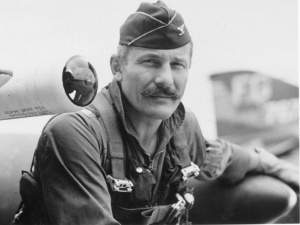
See also
- Related development
- Aircraft of comparable role, configuration and era
- Mikoyan-Gurevich MiG-21 (Family)
- SAAB J35D Draken
- Dassault Mirage IIIC
External links
- [Development] F-4C Phantom II: The Record Breaker
- Official data sheet - more details about the performance
Citations
Biblography
- Hachette Partworks LTD. (2019). McDonnell F-4 Phantom II - The Greatest Warplane in the West. (5th ed.). London: Hachette Partworks LTD. ISSN:2517-259X
- Joiner, Stephen. "What Couldn't the F-4 Phantom Do?", Air & Space Magazine, On-line, March 2015. Retrieved on 27 September 2019.
- Roblin, Sebastien. "Why You Need to Respect the McDonnell Douglas F-4 Phantom II Fighter" Nationalinterest.org website, On-line 17 April 2019. Retrieved on 27 September 2019.
| McDonnell Aircraft Corporation | |
|---|---|
| Jet Fighters | F2H-2 · F3H-2 |
| F-4C Phantom II · F-4E Phantom II · F-4J Phantom II · F-4S Phantom II | |
| F-15A · F-15C MSIP II · F-15E | |
| Strike Aircraft | AV-8B Plus · AV-8B (NA) |
| Helicopters | AH-6M |
| Export/Licensed | |
| Aircraft | ◄F-4F Early · ◄F-4F · ◄F-4F KWS LV · Phantom FG.1 · Phantom FGR.2 · F-4J(UK) Phantom II · F-4EJ Phantom II · F-4EJ ADTW · Kurnass · Kurnass 2000 |
| F-15J · F-15J(M) · Baz · Baz Meshupar · F-15I Ra’am | |
| ▄AV-8B Plus | |
| Helicopters | Lahatut |
| The McDonnell Aircraft Corporation merged with Douglas Aircraft Company in 1967 to form McDonnell Douglas Corporation. Later it was merged with The Boeing Company in 1997. | |
| See Also | Mitsubishi Heavy Industries |
| USA jet aircraft | |
|---|---|
| Fighters | |
| F9F | F9F-2 · F9F-5 · F9F-8 |
| F-80 | F-80A-5 · F-80C-10 |
| F-84 | F-84B-26 · F-84F · F-84G-21-RE |
| F-86 | F-86A-5 · F-86F-25 · F-86F-2 · F-86F-35 |
| F-89 | F-89B · F-89D |
| F-100 | F-100D |
| F-104 | F-104A · F-104C |
| F-4 | F-4C Phantom II · F-4E Phantom II · F-4J Phantom II · F-4S Phantom II |
| F-5 | F-5A · F-5C · F-5E · F-20A |
| F-8 | F8U-2 · F-8E |
| F-14 | F-14A Early · ▄F-14A IRIAF · F-14B |
| F-15 | F-15A · F-15C MSIP II · F-15E |
| F-16 | F-16A · F-16A ADF · F-16C |
| Other | P-59A · F2H-2 · F3D-1 · F3H-2 · F4D-1 · F11F-1 |
| Strike Aircraft | |
| FJ-4 | FJ-4B · FJ-4B VMF-232 |
| A-4 | A-4B · A-4E Early |
| A-7 | A-7D · A-7E · A-7K |
| AV-8 | AV-8A · AV-8C · AV-8B Plus · AV-8B (NA) |
| A-10 | A-10A · A-10A Late · A-10C |
| F-111 | F-111A · F-111F |
| Other | A-6E TRAM · F-105D · F-117 |
| Bombers | |
| B-57 | B-57A · B-57B |


